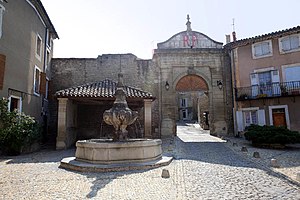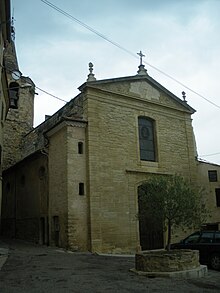Malemort-du-Comtat
| Malemort-du-Comtat | ||
|---|---|---|

|
|
|
| region | Provence-Alpes-Cote d'Azur | |
| Department | Vaucluse | |
| Arrondissement | Carpentras | |
| Canton | Pernes-les-Fontaines | |
| Community association | Ventoux Sud | |
| Coordinates | 44 ° 1 ′ N , 5 ° 10 ′ E | |
| height | 160–364 m | |
| surface | 11.92 km 2 | |
| Residents | 1,782 (January 1, 2017) | |
| Population density | 149 inhabitants / km 2 | |
| Post Code | 84570 | |
| INSEE code | 84070 | |
| Website | http://www.malemortducomtat.fr/ | |
 Fountain in front of the Grand-Porte |
||
Malemort-du-Comtat is a French commune with 1,782 inhabitants (at January 1, 2017) in the department of Vaucluse in the region Provence-Alpes-Cote d'Azur .
geography
Malemort-du-Comtat is located at the western exit of the Gorges de la Nesque , between Carpentras and the Monts de Vaucluse . The Nesque forms part of the southern municipal boundary. Surrounding communities are Venasque in the southwest, Méthamis in the southeast, Blauvac in the east and Mazan in the north.
history
Traces of settlement of the place go back to 5000 BC. BC back to the Neolithic . Numerous finds from the Stone, Bronze and Roman times come from the grounds of Unang Castle. The castle got its name from a Gallo-Roman villa called Villa Unango that was once located here.
During the Migration Period , an important battle decimated the local population. A few decades later, around 875, Charles, King of Provence-Viennois, gave the Villa Unango, along with its outbuildings, lands and vineyards, to Johannes, Bishop of Carpentras .
The village was mentioned for the next time in 1160. Raimund V , Count of Toulouse and Margrave of Provence, sold the Castle of Venasque, to which Malemort and the Villa S. Felice (Saint-Félix Castle) were attached, to Bishop Raimond I for 2000 sou .
In 1348 a large part of the population fell victim to the Great Plague . Towards the end of the 14th century, the village was fortified by a wall flanked by eleven towers. It was accessible through three gates that are still preserved today.
In 1720 the community was hit by another plague epidemic. To keep the plague away from the rest of the population, a wall was built across the village, which ran along what is now Rue l'Endroune . Some remains of the wall are still visible today.
In 1791 Malemort-du-Comtat was annexed to France together with the Comtat Venaissin .
Population development
| year | 1962 | 1968 | 1975 | 1982 | 1990 | 1999 | 2006 | 2010 |
|---|---|---|---|---|---|---|---|---|
| Residents | 733 | 746 | 706 | 814 | 985 | 1,203 | 1,383 | 1,510 |
Attractions
- Saint-Félix castle , former summer residence of the bishops of Carpentras and birthplace of the Provence poet Félix Gras (1844–1901).
- Fountain at the Grand-Porte (city gate) from 1789, Monument historique since October 28, 1949.
- further fountains and lavoirs in and around the village.
- Pre-Roman altar, found in St. Antonin, parts are on display in the Mairie .
- In the church there are various objects from the former Sainte-Garde chapel , including an altarpiece, a group of statues with Joseph and Mary, and a group with four gilded wooden figures, the Ste. Elisabeth, Ste. Representing Anne, St. Joachim and St. Zacharie. All six statues are attributed to Jacques Bernus and date before his death in 1728. The objects have been a protected cultural property since May 3, 1933. On the same day, a relic made of glass and gilded copper from 1786 was placed under protection , the relic box is decorated with the coat of arms of its donor, Bishop Beni.
Web links
- Official website (French)
Individual evidence
- ↑ a b c d History of the community. (No longer available online.) Malemort-du-Comtat official website, archived from the original on September 9, 2009 ; Retrieved June 1, 2013 (French). Info: The archive link was inserted automatically and has not yet been checked. Please check the original and archive link according to the instructions and then remove this notice.
- ↑ a b c d Robert Bailly: Dictionnaire des communes du Vaucluse. 1986, p. 252.
- ^ Jean-Pierre Saltarelli: Les Côtes du Ventoux, origines et originalités d'un terroir de la vallée du Rhône. 2000, p. 28.
- ↑ Entry no. PA00082071 in the Base Mérimée of the French Ministry of Culture (French)
- ↑ Entry No. 84070 in the Base Palissy of the French Ministry of Culture (French)
- ↑ Photos in the Base Mémoire: Entry No.AP61P00222 , Entry No.AP61P00223 .

